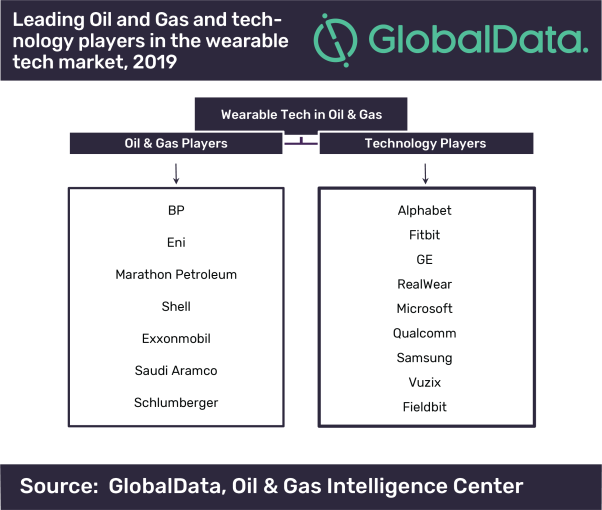05 Sep, 2019 Wearable tech poised to increase workforce safety and productivity in oil and gas operations
Posted in Oil & GasOil and gas companies are evaluating the possibilities of deploying wearable devices in day-to-day operations to improve safety and effiency in oilfield operations, says GlobalData, a leading data and analytics company.
Initial research is focused on enabling real-time monitoring of field technicians to ensure their safety and in providing them with audiovisual assistance to perform asset maintenance, with the hopes of adopting lightweight, yet rugged wearable devices.
GlobalData’s latest thematic report, ‘Wearable Tech in Oil & Gas’, states that wearable devices can augment natural human capabilities, such as enhanced vision or smell, thereby adding to productivity and safety in oil field operations. These features of wearable tech are encouraging oil and gas companies to adopt helmets, smart glasses, wristbands, and other devices that incorporate technologies such as wireless connectivity, artificial intelligence (AI) and augmented reality (AR).
Ravindra Puranik, Oil & Gas Analyst at GlobalData, comments: “Mobility is considered as the key driver and precursor to implement any wearable tech in the oil and gas industry. Ever since the evolution of digital technologies, companies in the oil and gas sector are using industry-grade smartphones to capture field-level data and exchange information with onshore experts. Instead of handheld smartphones, hands-free devices will increase work efficiency among the frontline workforce. Through different applications, wearable smart devices are expected to bring a paradigm shift in oil and gas field operations.”
Wearable devices are also designed to provide safety to field staff by monitoring the wearer’s health condition, alerting them from exposure to potential hazards and also providing access to live locations of workers to the onshore support team. This, in turn, provides a sense of security among the workers and increases productivity.
Puranik adds: “The increasing integration of wearable technologies with big data, AI, and cloud computing is enabling faster and deeper penetration of wearable devices. The oil and gas industry is integrating wearable tech with inspection and maintenance technologies to improve data collection and minimize risk to its workforce. Unlike the consumer sector, wearable devices in the oil and gas industry are made to withstand extreme temperature variations and resist oil, chemical spills, heavy rain, and dust among other things, making the working environment more secure.”
GlobalData’s thematic research identifies oil and gas companies, such as BP and Shell, among the leading adopters of wearable technology. Besides these, several other companies including, Saudi Aramco, Eni, Marathon Petroleum, Chevron, ExxonMobil, Baker Hughes, Schlumberger, and NOV have also started incorporating wearable tech in their operations.

